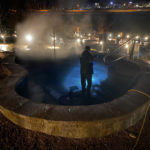
13 May J-Wellness: Health Trends that are Catching on in the West
Referred to as J-Wellness, these ancient and modern practices from Japan translate to health around the world.
A convergence of historical, social, cultural, natural, and innovative practices has brought such global attention to Japanese wellness, known J-Wellness. The recognition is earned by results. Japan has the highest percentage of centenarians in the world, and half of its citizens born in 2007 are expected to reach age 107. The holistic approach brings together everything from ancient rituals to modern fads to create better physical and mental health. With Japan scheduled to host the pandemic-delayed Olympics, global awareness of these benefits is likely to accelerate. Here are some of the major practices that can translate anywhere in the world:
Onsen . The practice of soaking in mineral hot springs goes back at least to the sixth century. Japan has nearly 21,000 hot springs, twice as many as the rest of the world combined. Immersion in water is sought-after for relieving stress, improving circulation, and other positive health effects.
. The practice of soaking in mineral hot springs goes back at least to the sixth century. Japan has nearly 21,000 hot springs, twice as many as the rest of the world combined. Immersion in water is sought-after for relieving stress, improving circulation, and other positive health effects.
Shinrin-Yoku. “Forest bathing” started in 1982 as part of a Japanese health program. In 2018, 2.5 million people walked trails in the 62 healing forests, and 1,200 people have been certified to guide the practice. Research says the immersion in nature can lower blood pressure, stress, and blood sugar and boost cardiovascular and vascular health, concentration, memory, and energy.
Iki-iki. Social connection is an important factor in physical and mental health. Japan is building Iki-iki plazas in neighborhoods so that people across generations can gather to play, learn, and get to know each other. This is related to a mental illness prevention and workplace environment improvement initiative called the Stress Check Program supported by corporations because it boosts productivity.
 Kintsugi. A popular art movement in Japan focuses on repairing broken pottery with gold, silver, or platinum— making the object even stronger than before. The practice provides a metaphor for the mindset of embracing imperfections, including personal ones, and creating something beautiful—a source of hope, optimism, and better mental health.
Kintsugi. A popular art movement in Japan focuses on repairing broken pottery with gold, silver, or platinum— making the object even stronger than before. The practice provides a metaphor for the mindset of embracing imperfections, including personal ones, and creating something beautiful—a source of hope, optimism, and better mental health.
Matcha. Green tea, used by Buddhist monks for meditation and samurai warriors for energy, is ubiquitous in Japan. In addition to its antioxidant and low-caffeine health benefits, it provides an occasion for socializing.
Shojin Ryori. This vegan cuisine is based on the diet of Buddhist monks dating to the sixth century. It is based on soybean foods such as tofu, vegetables, wild plants, and nuts. The meals include five colors—green, red, yellow, black, and white—and five flavors—sweet, sour, salty, umami, and bitter.
KonMari. The 21st-century focus on de-cluttering led by Marie Kondo of Tokyo, boosted in 2019 by a Netflix series, aims to boost mental health by elevating mindfulness and introspection and removing what does not “spark joy.”
Hanami. The ancient practice of meditating among the cherry blossoms is more than another way of being in nature and appreciating beauty. The festival for the brief blooming season reflects a mindset that accepts impermanence—mono no aware, meaning “nothing lasts forever.”
Learn more about health and wellness topics at Iron Mountain Hot Springs.
Gene Stowe
Latest posts by Gene Stowe (see all)
- Skin in the Game: High Altitude Skin Care - June 18, 2021
- J-Wellness: Health Trends that are Catching on in the West - May 13, 2021
- Active and Engaged: Senior Movement - April 9, 2021
- Good Vibrations: The Benefits of Wellness Music - March 10, 2021





